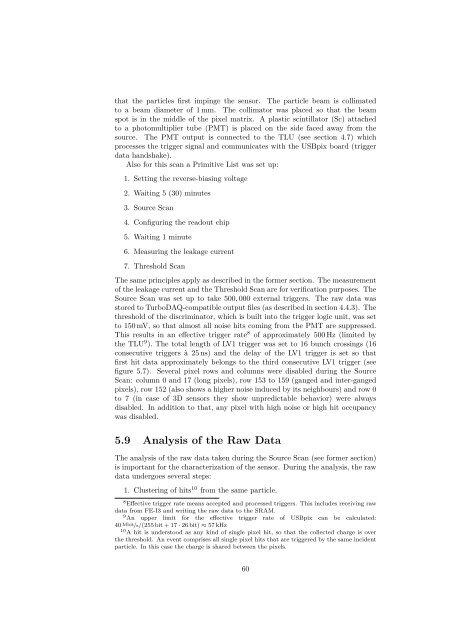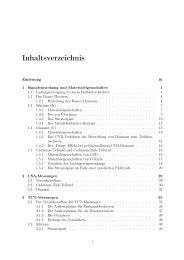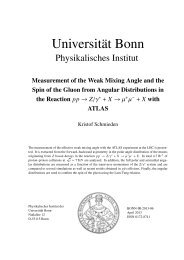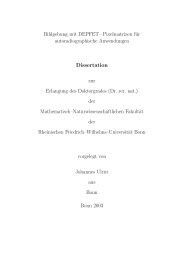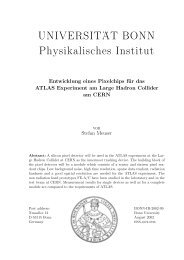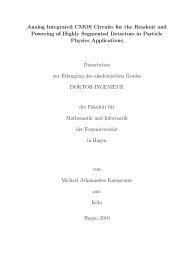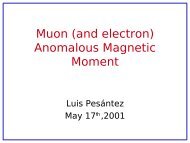Jens Janssen Diploma Thesis - Prof. Dr. Norbert Wermes ...
Jens Janssen Diploma Thesis - Prof. Dr. Norbert Wermes ...
Jens Janssen Diploma Thesis - Prof. Dr. Norbert Wermes ...
Create successful ePaper yourself
Turn your PDF publications into a flip-book with our unique Google optimized e-Paper software.
that the particles first impinge the sensor. The particle beam is collimatedto a beam diameter of 1mm. The collimator was placed so that the beamspot is in the middle of the pixel matrix. A plastic scintillator (Sc) attachedto a photomultiplier tube (PMT) is placed on the side faced away from thesource. The PMT output is connected to the TLU (see section 4.7) whichprocesses the trigger signal and communicates with the USBpix board (triggerdata handshake).Also for this scan a Primitive List was set up:1. Setting the reverse-biasing voltage2. Waiting 5 (30) minutes3. Source Scan4. Configuring the readout chip5. Waiting 1 minute6. Measuring the leakage current7. Threshold ScanThe same principles apply as described in the former section. The measurementof the leakage current and the Threshold Scan are for verification purposes. TheSource Scan was set up to take 500, 000 external triggers. The raw data wasstored to TurboDAQ-compatible output files (as described in section 4.4.3). Thethreshold of the discriminator, which is built into the trigger logic unit, was setto 150 mV, so that almost all noise hits coming from the PMT are suppressed.This results in an e ective trigger rate 8 of approximately 500 Hz (limited bythe TLU 9 ). The total length of LV1 trigger was set to 16 bunch crossings (16consecutive triggers à 25 ns) and the delay of the LV1 trigger is set so thatfirst hit data approximately belongs to the third consecutive LV1 trigger (seefigure 5.7). Several pixel rows and columns were disabled during the SourceScan: column 0 and 17 (long pixels), row 153 to 159 (ganged and inter-gangedpixels), row 152 (also shows a higher noise induced by its neighbours) and row 0to 7 (in case of 3D sensors they show unpredictable behavior) were alwaysdisabled. In addition to that, any pixel with high noise or high hit occupancywas disabled.5.9 Analysis of the Raw DataThe analysis of the raw data taken during the Source Scan (see former section)is important for the characterization of the sensor. During the analysis, the rawdata undergoes several steps:1. Clustering of hits 10 from the same particle.8 E ective trigger rate means accepted and processed triggers. This includes receiving rawdata from FE-I3 and writing the raw data to the SRAM.9 An upper limit for the e ective trigger rate of USBpix can be calculated:40 Mbit/s/(255 bit + 17 · 26 bit) ¥ 57 kHz10 Ahitisunderstoodasanykindofsinglepixelhit,sothatthecollectedchargeisoverthe threshold. An event comprises all single pixel hits that are triggered by the same incidentparticle. In this case the charge is shared between the pixels.60


